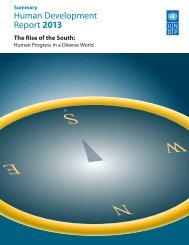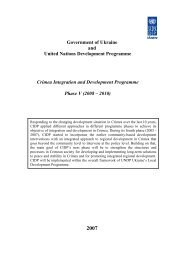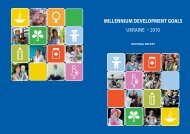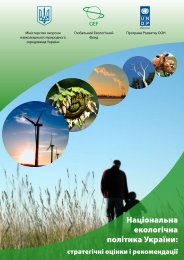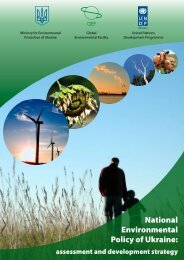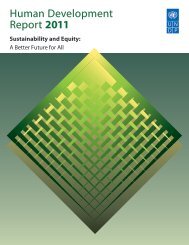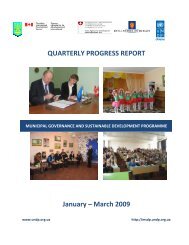E N S W - United Nations Development Programme
E N S W - United Nations Development Programme
E N S W - United Nations Development Programme
Create successful ePaper yourself
Turn your PDF publications into a flip-book with our unique Google optimized e-Paper software.
• Turkey. The state created favourable economic<br />
conditions that encouraged construction<br />
and the manufacture of furniture, textiles,<br />
food and automobiles—all industries with<br />
a high capacity to absorb labour. Turkey’s<br />
export basket has since moved towards products<br />
that involve more processing, higher<br />
technology content and the use of skilled<br />
labour. 40<br />
• Tunisia. Since the early 1970s, Tunisia has<br />
relied on financial and fiscal incentives<br />
to attract foreign and domestic capital to<br />
export-oriented industries, particularly for<br />
garment production. 41 Various forms of<br />
business– government relations have enhanced<br />
industrial upgrading and promoted<br />
industry clusters. Today, Tunisia is among the<br />
top five exporters of apparel to the European<br />
Union. 42 It also has the potential to export<br />
health services by providing treatment to visitors<br />
from neighbouring countries, to a value<br />
equivalent to a quarter of Tunisia’s private<br />
health sector output. 43<br />
• Chile. After returning to democracy in the<br />
1990s, Chile encouraged investment and<br />
technological upgrading in sectors where<br />
the country had an intrinsic comparative<br />
advantage. It subsidized the formation and<br />
operation of innovation-based consortia<br />
between private firms and universities and<br />
engaged in other innovation-promoting<br />
activities. 44<br />
Committing to long-term<br />
development and reform<br />
Achieving enduring transformation is a longterm<br />
process that requires countries to chart a<br />
consistent and balanced approach to development.<br />
Some technical or managerial solutions<br />
may appear to be attractive quick fixes, but they<br />
are generally inadequate.<br />
• China. Since market-oriented reforms in the<br />
late 1970s, China has experienced a “complex<br />
and interlocking set of changes: from a<br />
command to a market economy; from rural<br />
to urban; from agriculture to manufacturing<br />
and services; from informal to formal<br />
economic activities; from a fragmented set<br />
of fairly self-sufficient provincial economies<br />
to a more integrated economy; and from<br />
an economy that was fairly shut off from<br />
the world to a powerhouse of international<br />
trade”. 45 The scale of these changes required<br />
a committed state pursuing a long-term vision<br />
to build the necessary institutions and<br />
capacities. The leadership deliberately replaced<br />
the old guard, who might have been<br />
expected to resist change, with a younger,<br />
more open and better educated government<br />
bureaucracy. By 1988, a remarkable 90% of<br />
officials above the county level had been<br />
appointed since 1982. 46 Capacity upgrading<br />
is still a priority, and the education levels<br />
of officials have risen continuously. The<br />
Chinese bureaucracy has been designed<br />
with a strong results orientation, linking<br />
career development to the achievement of<br />
central objectives of modernization and<br />
economic progress. 47<br />
People-friendly developmental states need<br />
strong political leadership committed to equity<br />
and sustainability. Effective leadership<br />
aligns the long-term goals of policymakers and<br />
enables constituencies to appreciate the state’s<br />
work in fostering individual capabilities and<br />
social integration for human development. This<br />
requires a balanced approach to development<br />
and an ability to convert crises into opportunities<br />
for introducing broad-based economic<br />
reforms.<br />
• Brazil. By the time the Brazilian transformation<br />
to a developmental state began<br />
(around 1994), the government had implemented<br />
macroeconomic reforms to control<br />
hyperinflation through the Real Plan and<br />
concluded the trade liberalization that had<br />
begun in 1988 with tariff reductions and<br />
the removal of other restrictions. 48 Trade<br />
openness and prudent monetary and fiscal<br />
policy followed, as did innovative social programmes<br />
that reduced poverty and income<br />
inequality.<br />
In large and complex societies, the outcome<br />
of any particular policy is inevitably uncertain.<br />
<strong>Development</strong>al states need to be pragmatic and<br />
test a range of different approaches.<br />
• China. China’s reform and opening resulted<br />
from an explicit choice in the late 1970s to<br />
relax constraints on people’s participation<br />
in economic decisions. But the institutional<br />
innovations that went on to underpin<br />
China’s transformation resembled Deng<br />
Xiaoping’s approach to “crossing the river<br />
People-friendly<br />
developmental states<br />
need strong political<br />
leadership committed to<br />
equity and sustainability<br />
Chapter 3 Drivers of development transformation | 73



